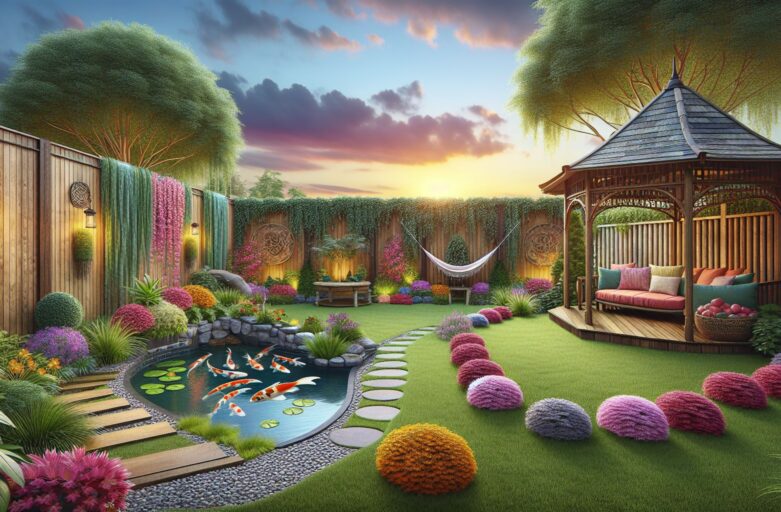Creating a perfect landscape design is about blending art with nature—taking what exists naturally within your outdoor space and enhancing it to create a relaxing, functional, and beautiful extension of your home. A thoughtfully designed landscape not only adds aesthetic appeal but also increases the value of your property. Below are expert tips and strategies for turning your yard into the personal oasis you’ve always dreamed of.
Understanding the Basics of Landscape Design
Before diving into specific projects, it’s essential to have a grasp of fundamental landscape design principles. Every successful design starts with a well-thought-out plan that considers the following:
- Unity: This principle is about creating a harmonious blend of all the different elements in your garden—from plants to hardscaping—so they work together as a coordinated whole.
- Balance: Achieving balance means ensuring that no single part of the garden overwhelms the others, maintaining a sense of equality.
- Contrast and Harmony: Contrasting elements draw the eye and create visual interest, while harmony gives the landscape a coherent feel.
- Color: Use color theory to create a palette that suits the mood you want to evoke—warm colors for excitement and cooler tones for a more relaxing vibe.
- Scale: Consider the proportion of your garden elements to prevent certain features from dominating the space inappropriately.
The Art of Mixing Hard and Softscaping
To achieve a dynamic and visually appealing outdoor space, incorporate both hardscaping and softscaping elements into your design:
- Hardscaping: This refers to the non-living elements in your yard, such as patios, decks, retaining walls, sidewalks, and other structures. They form the foundation and structure of your landscape.
- Softscaping: Comprised of the living, horticultural elements of your garden like trees, bushes, flowers, and grass. These elements add life and color to the landscape.
Developing a Cohesive Garden Design
When you’re developing the design for your garden, it’s not just about planting a few flowers and calling it a day. Rather, you’ll need to consider:
- Theme: A theme can unify your landscape and guide your plant and material selections. Themes can be as simple as using consistent shapes or colors, or as complex as creating a relaxation garden or an oriental garden.
- Plants: Choose plants that reflect your theme, are suitable for your climate, and serve your needs. Consider how they interact—with varied textures, scents, and heights.
- Focal Points: Every garden needs a focal point or series of focal points. These can be structures, distinct plants, or unique garden features.
Incorporating Outdoor Living Spaces Into Your Landscape
Integrate areas for relaxation and entertainment into the landscape design with the addition of:
- Patios and Decks: These are perfect for seating, dining areas, and hosting gatherings.
- Outdoor Kitchens: Elevate your entertainment potential with a fully equipped outdoor kitchen.
- Fire Pits and Fireplaces: They serve as year-round focal points and cozy gathering spots.
Enhancing Your Garden with Water Features
Adding a water feature such as a pond or fountain can create tranquility and add an elegant touch to your garden. When planning a water feature:
- Consider the size and scale relative to your garden.
- Choose a style that complements your overall landscape design.
- Think about the maintenance a water feature will require.
Practical Aspects of Landscape Design: Irrigation and Drainage
Proper irrigation and drainage are essential for keeping your garden healthy:
- Irrigation: A good irrigation system will ensure that your plants receive the right amount of water without waste.
- Drainage: Effective drainage solutions prevent water accumulation that can damage both plants and hardscape structures.
The Importance of Landscape Lighting
Landscape lighting serves both a practical purpose and an aesthetic one:
- Illuminate paths and steps for safety.
- Highlight garden features and plants.
- Create ambiance for evening enjoyment of your outdoor space.
Year-Round Maintenance for Eternal Beauty
Consistent landscape maintenance is key to preserving the beauty and functionality of your outdoor space through:
- Regular pruning and trimming of trees and plants.
- Seasonal cleanups to remove fallen leaves and debris.
- Pest control and weed management to protect your garden.
Tree Care: An Integral Element of Landscape Maintenance
Trees require specialized attention to remain healthy and attractive:
- Pruning and Trimming: These practices maintain the shape of your trees and can prevent tree diseases and safety hazards.
- Tree Health Assessments: Regular inspections by a certified arborist can spot early signs of disease or pests.
- Tree Removal and Stump Grinding: Sometimes necessary for safety or health reasons, these actions should be performed by professionals.
Conclusion
A well-designed landscape is a living work of art that enhances the beauty and usability of your property. From planting the right shrubs to installing an elaborate water feature, every element plays a crucial role. By considering the blend of softscaping and hardscaping, creating outdoor living spaces, addressing practicalities like irrigation, and preserving the health of your greenery, you can develop a haven right in your backyard that is both pleasing to the eye and a joy to inhabit. Remember, successful landscape design is about creating a harmonious balance that reflects your personal style and complements your home’s architecture. With this guide, your dream landscape is within reach—start planning your personal oasis today!
